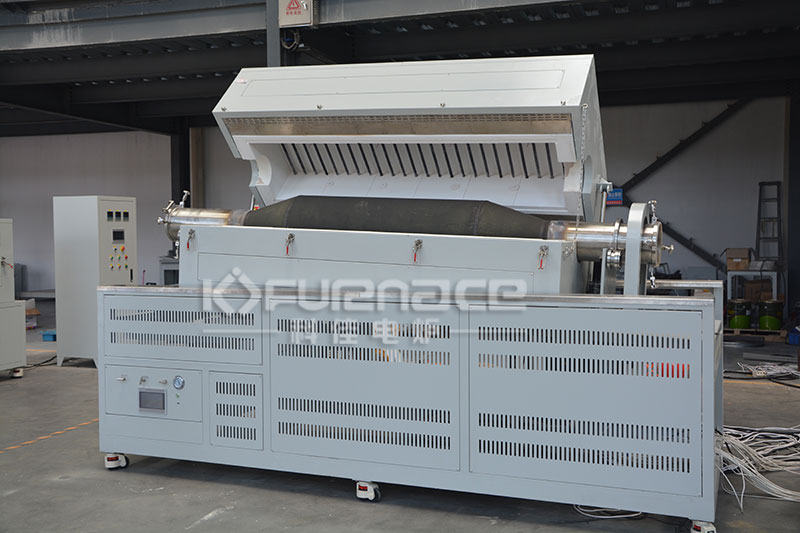The large-diameter tube furnace can be made into a multi temperature zone structure, and the multi temperature zone design can greatly enhance its functionality and application range. Let’s take a detailed look below!

Rotating tube furnace commonly used for powder sintering (click on the image to view product details)
1. Technical implementation method
Independent heating and temperature control system
Each temperature zone is equipped with independent heating elements (such as silicon carbide rods, resistance wires) and temperature sensors, which achieve precise temperature control through PID intelligent algorithm. For example, a large diameter tube furnace with four temperature zones has a heating zone diameter of 400mm and two ends with a diameter of 200mm. Each temperature zone can have a separate temperature curve to ensure temperature uniformity (within ± 5 ℃) inside the furnace.
Thermal insulation structure design
Using multi-layer ceramic fiber or alumina fiber insulation layer to reduce thermal interference in the temperature range. For example, a certain device can maintain efficient thermal isolation even under large pipe diameters (such as 300mm) by optimizing insulation materials to control the longitudinal temperature gradient within ± 5 ℃/m.
modular combination
The furnace body adopts a segmented modular design, and each temperature zone can be independently disassembled or expanded. For example, the heating zone length of a 1200 ℃ three temperature zone tube furnace is 900mm (300mm for each of the three temperature zones), and users can adjust the number or layout of temperature zones according to their needs.
2. The core advantage of multi temperature zone design
Temperature gradient control
Material synthesis: In processes such as CVD deposition and crystal growth, multiple temperature zones can simulate temperature gradients in actual production. For example, in the preparation of graphene, the carbon source is decomposed in the high temperature zone (1000 ℃) in the front section, the deposition rate is controlled in the medium temperature zone (800 ℃) in the middle section, and the ordered lattice arrangement is promoted in the low temperature zone (500 ℃) in the back section, thereby obtaining high-quality thin films.
Heat treatment optimization: In metal heat treatment, controlling the cooling rate through multiple temperature zones can refine the grain structure, improve material strength and toughness. For example, a new energy vehicle enterprise uses a multi temperature zone tube furnace to optimize the sintering process of ternary materials and improve material compaction density.
Continuous process integration
Full process processing: Single temperature zone furnaces require multiple furnace openings to transfer samples, while multi temperature zone furnaces can achieve the entire process of preheating, reaction, cooling, etc. in the same furnace. For example, in semiconductor device manufacturing, samples can be sequentially subjected to low-temperature oxidation layer removal, medium temperature doping, and high-temperature annealing isothermal zone to avoid intermediate contamination and oxidation, and shorten processing time.
Collaborative processing: It can simultaneously process materials that require different temperature conditions. For example, in the preparation of composite materials, the ceramic matrix needs to be sintered at 1200 ℃, while the metal reinforcement phase needs to be tempered at 800 ℃. Multi zone furnaces can achieve collaborative processing through zone temperature control.
Experimental flexibility and efficiency
Parameter comparison experiment: Each temperature zone can be individually set with parameters such as temperature, heating rate, and holding time, supporting comparative experimental design. For example, when studying alloy phase transformation, different cooling rate temperature zones can be set simultaneously to compare the differences in material microstructure.
Energy saving and cost optimization: By reducing the number of device starts and stops and heat loss, energy consumption can be lowered. For example, a 300mm diameter equipment has lower power consumption at 1200 ℃ and is more energy-efficient when equipped with a waste heat recovery system.

Customized six temperature zone high-temperature rotary furnace (click on the image to view product details)
3. Typical application scenarios
Preparation of new energy materials
Lithium ion battery electrode material: Multi temperature zone furnace can achieve continuous processing steps such as precursor mixing, pre firing, and high-temperature solid-state reaction. For example, a certain research institute has utilized the multi temperature zone function to significantly shorten the development cycle of the sintering process for new lithium cobalt oxide materials.
Solar cell materials: By controlling the temperature range, optimizing the crystal structure, and improving the photoelectric conversion efficiency. For example, in the preparation of silicon-based materials, a multi zone furnace can achieve full process control from low-temperature deoxidation to high-temperature melting.
Semiconductor and Electronics Industry
Wafer annealing and oxide layer growth: Multi zone furnaces can accurately control doping concentration and oxide layer thickness to meet high-precision manufacturing requirements.
Nanomaterial synthesis: Used for the controllable synthesis of nanomaterials such as quantum dots and carbon nanotubes, adjusting reaction kinetics parameters through temperature gradients. For example, a certain device successfully shortened the sintering time of a specific material through multi temperature zone control.
Metallurgical and Ceramic Industry
Metal melting and alloy preparation: By heating and melting metals in different temperature zones, precise control of metal composition is achieved. For example, in the preparation of high-temperature alloys, multi zone furnaces can ensure uniform mixing of various components and improve product quality.
Ceramic product firing: uniform heating ensures the mechanical properties and chemical stability of the product, suitable for large-scale production of ceramic tiles, sanitary ceramics, etc.Click to learn more Customized tube furnaces! Or click on online customer service to learn more about product information!